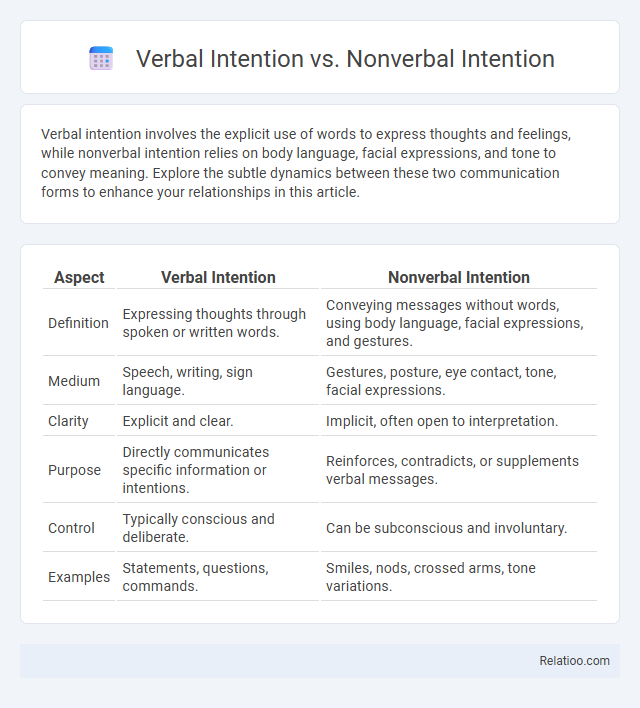Verbal intention involves the explicit use of words to express thoughts and feelings, while nonverbal intention relies on body language, facial expressions, and tone to convey meaning. Explore the subtle dynamics between these two communication forms to enhance your relationships in this article.
Table of Comparison
| Aspect | Verbal Intention | Nonverbal Intention |
|---|---|---|
| Definition | Expressing thoughts through spoken or written words. | Conveying messages without words, using body language, facial expressions, and gestures. |
| Medium | Speech, writing, sign language. | Gestures, posture, eye contact, tone, facial expressions. |
| Clarity | Explicit and clear. | Implicit, often open to interpretation. |
| Purpose | Directly communicates specific information or intentions. | Reinforces, contradicts, or supplements verbal messages. |
| Control | Typically conscious and deliberate. | Can be subconscious and involuntary. |
| Examples | Statements, questions, commands. | Smiles, nods, crossed arms, tone variations. |
Understanding Verbal Intention
Understanding verbal intention involves interpreting the explicit meaning conveyed through spoken or written language, which is critical for effective communication and reducing misunderstandings. Verbal intention differs from nonverbal intention, which relies on body language, facial expressions, and tone to express meaning beyond words. Analyzing verbal intention requires attention to context, syntax, and semantics to accurately grasp the speaker's purpose and desired response.
Defining Nonverbal Intention
Nonverbal intention refers to the purposeful communication conveyed through body language, facial expressions, gestures, and other nonverbal cues that reveal a person's underlying motives or feelings without spoken words. Unlike verbal intention, which relies on explicit linguistic expressions, nonverbal intention provides subtle yet powerful context that helps others interpret your true message. Understanding the distinction between verbal, nonverbal, and general intention enhances your ability to decode interactions and respond effectively.
Key Differences Between Verbal and Nonverbal Intention
Verbal intention involves the deliberate use of spoken or written language to convey a specific message or purpose, characterized by explicit communication through words. Nonverbal intention, by contrast, relies on body language, facial expressions, gestures, and tone of voice to express meaning without spoken words, often conveying emotions or attitudes subconsciously. The key difference lies in verbal intention's reliance on structured linguistic elements and explicit clarity, whereas nonverbal intention communicates implicitly through physical and vocal cues, influencing interpretation beyond the literal verbal message.
The Role of Context in Interpreting Intention
Interpreting verbal intention relies heavily on the context in which words are spoken, as the same phrase can imply different meanings depending on situational factors. Nonverbal intention--expressed through gestures, facial expressions, and tone--adds layers of meaning that complement or contradict spoken language, influencing your understanding of true intent. The role of context shapes both verbal and nonverbal cues, making it essential to consider environmental, cultural, and relational factors to accurately grasp intention in communication.
Common Examples of Verbal Intention
Verbal intention primarily involves conveying purpose or emotion through spoken or written language, such as stating a request, giving instructions, or expressing feelings. Common examples include saying "I want to help," issuing a command like "Please sit down," or making promises like "I will call you tomorrow." Your ability to interpret these verbal intentions accurately relies on context, tone, and word choice, distinguishing them from nonverbal cues like body language or facial expressions.
Powerful Nonverbal Cues and Their Meanings
Powerful nonverbal cues such as facial expressions, body language, and eye contact play a critical role in conveying intention beyond spoken words. While verbal intention relies on explicit language to communicate purpose, nonverbal intention often reveals true emotions and unspoken desires, providing deeper insight into a person's mindset. Understanding the meanings behind gestures like crossed arms, nodding, or maintaining personal space enhances interpretation of intentions in social and professional interactions.
The Intersection of Verbal and Nonverbal Communication
Verbal intention refers to the explicit meaning conveyed through spoken or written words, while nonverbal intention encompasses body language, facial expressions, and tone that communicate underlying emotions or attitudes. The intersection of verbal and nonverbal communication creates a holistic understanding of intention, where your message gains clarity and depth when both forms align. Discrepancies between verbal and nonverbal cues can lead to misinterpretation, emphasizing the importance of recognizing and synchronizing these elements in effective communication.
Challenges in Perceiving Authentic Intentions
Verbal intention often faces challenges in perception due to ambiguity in language and the potential for deception, while nonverbal intention relies heavily on interpreting body language and facial expressions, which can be culturally variable and easily misread. Authentic intention becomes difficult to discern because individuals may mask true motives through controlled verbal and nonverbal cues, complicating accurate recognition. Research in psychology and communication highlights that integrating both verbal and nonverbal signals enhances understanding but does not eliminate misunderstandings caused by personal biases and contextual factors.
Enhancing Communication Through Intentionality
Verbal intention involves the deliberate choice of words to convey a specific message clearly, while nonverbal intention encompasses body language, facial expressions, and tone that reinforce or alter the spoken message. Understanding the distinctions and interplay between verbal and nonverbal intentions enhances communication effectiveness by ensuring alignment between what is said and what is expressed physically. Intentionality in communication fosters trust, reduces misunderstandings, and strengthens interpersonal connections.
Practical Tips for Aligning Verbal and Nonverbal Intentions
Aligning your verbal and nonverbal intentions requires mindfulness of your body language, tone, and word choice to ensure they convey a consistent message. Practical tips include maintaining eye contact, matching your facial expressions with your spoken words, and using gestures that reinforce your statements. Training yourself to be aware of discrepancies between what you say and how you say it enhances clarity and builds trust in your communication.

Infographic: Verbal Intention vs Nonverbal Intention
 relatioo.com
relatioo.com